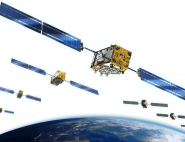Galileo Giove A/B
The GIOVE-A and GIOVE-B (Galileo In Orbit Validation Element) satellites were orbited as precursors to Galileo to test the technologies required for the future deployment of a positioning constellation. These tests enabled the European Space Agency (ESA) and the technology partners working on Galileo to validate data transmissions, frequencies and the satellite architecture for the first decade of operations.
The GIOVE missions were a key success.
Orbited on 28 December 2005 by a Soyuz launcher from Baikonur, GIOVE-A’s mission was to send the first positioning messages in Galileo format from the altitude at which the constellation would operate. A positioning satellite like GPS or Galileo sends frames of data at a specific frequency, encoding its identity and position within the constellation (its ephemeris) and the precise time of its internal atomic clock. The first validated Galileo message was sent by GIOVE-A on 7 May 2007. Assembled in the United Kingdom by Surrey Satellite Technology Ltd (SSTL), the satellite was lighter than the future Galileo satellites at 602 kilograms. Planned for a 27-month mission, GIOVE-A signed off in June 2012 but remains active as ESA is using its onboard GPS receiver to conduct other tests unrelated to Galileo.
GIOVE-B marked a new step forward in testing for Galileo. It was also sent aloft by Soyuz from Baikonur on 27 April 2008, and like GIOVE-A has transmitters for sending Galileo signals, only within a wider range of frequencies—using a multiplexed binary offset carrier or MBOC—for extra precision. But the main technology leap lies in its Passive Hydrogen Maser (PHM) clock, a world first. This particularly stable technology drifts only 1x10-14 seconds on average, equivalent to roughly one second every three million years. GIOVE-B also has two other more conventional rubidium clocks, prefiguring the redundant architecture of the Galileo satellites.
Built by the ESNI consortium (European Satellite Navigation Industry), GIOVE-B also completed its mission for ESA in 2012.


